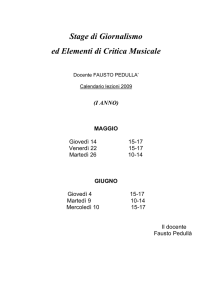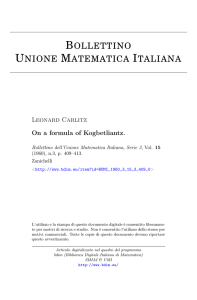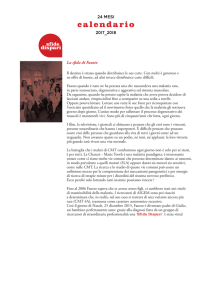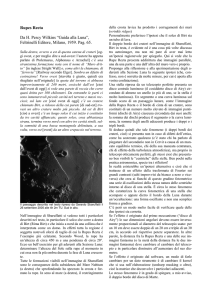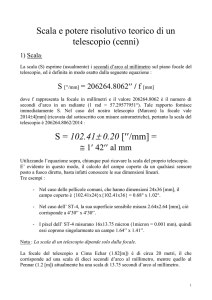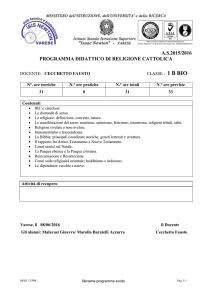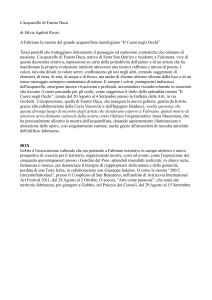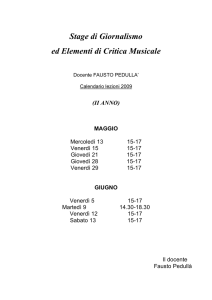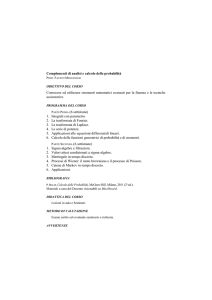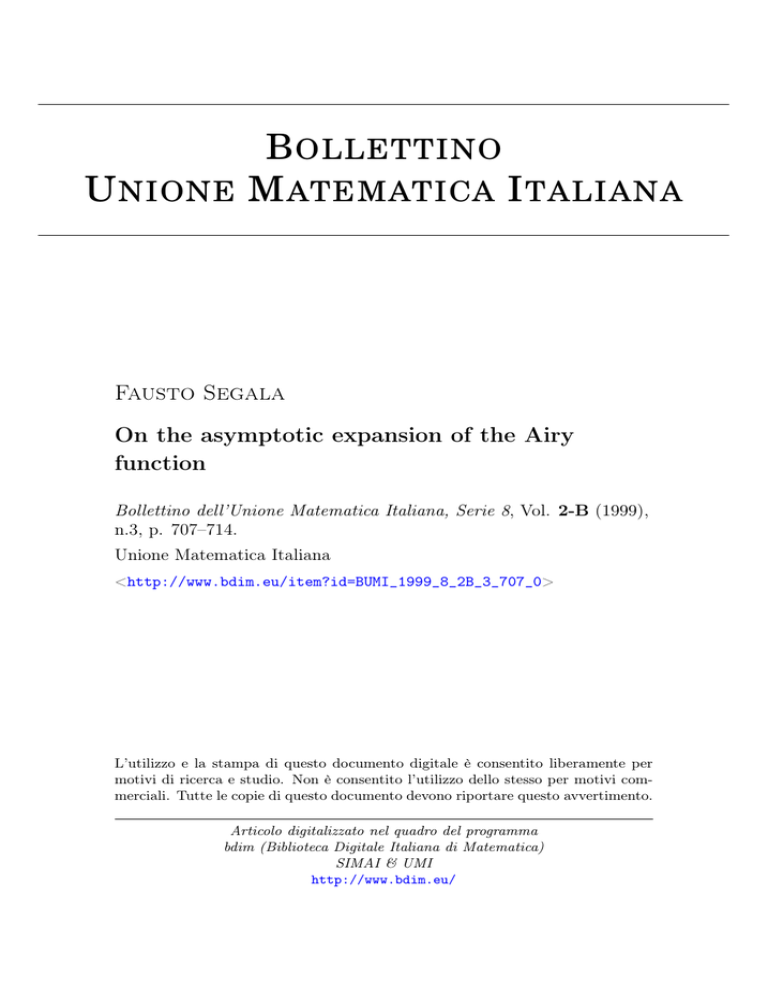
B OLLETTINO
U NIONE M ATEMATICA I TALIANA
Fausto Segala
On the asymptotic expansion of the Airy
function
Bollettino dell’Unione Matematica Italiana, Serie 8, Vol. 2-B (1999),
n.3, p. 707–714.
Unione Matematica Italiana
<http://www.bdim.eu/item?id=BUMI_1999_8_2B_3_707_0>
L’utilizzo e la stampa di questo documento digitale è consentito liberamente per
motivi di ricerca e studio. Non è consentito l’utilizzo dello stesso per motivi commerciali. Tutte le copie di questo documento devono riportare questo avvertimento.
Articolo digitalizzato nel quadro del programma
bdim (Biblioteca Digitale Italiana di Matematica)
SIMAI & UMI
http://www.bdim.eu/
Bollettino dell’Unione Matematica Italiana, Unione Matematica Italiana, 1999.
Bollettino U. M. I.
(8) 2-B (1999), 707-714
On the Asymptotic Expansion of the Airy Function.
FAUSTO SEGALA
Sunto. – Si prova una nuova formula di rappresentazione per la famosa funzione di
Airy. Ne viene data applicazione per la determinazione di certi bounds significativi per la funzione stessa.
1. – Introduction.
The famous Airy function is defined by
1iQ
Ai (r) 4
1
se
(z 3 /3 2 rz)
2 pi 2iQ
dz
and solves the Airy equation u 9 4 ru .
The Airy function (or the Airy integral) has many and very deep applications to mathematics, physics and engineering.
In 1963 Copson [1] gave the following representation of the Airy function
for r D 0 :
(1.1)
Ai (r) 4
1
2 kp
r 21 /4 e 22 /3 r 3 /2 q(r)
with
Q
(1.2)
q(r) 4
2
se
kp
0
2t 2
cos
g
r 23 /4 t 3
3
h
dt .
Since q(r) K 1 per r K Q , by (1.1) it follows
(1.3)
Ai (r) A
1
2 kp
3 /2
r 21 /4 e 22 /3 r ,
rKQ .
In this note we give a new representation of q(r). Precisely we prove that
708
FAUSTO SEGALA
q(r) can be written in the form
Q
(1.4)
q(r) 4
2
se
kp
2t 2
0
k
g h
t
r 3 /4
dt
where k(t) has the graph in the picture below:
Fig. 1.
As a consequence, q(r) has the graph in the next picture:
Fig. 2.
From (1.4) it follows in an absolutely elementary way, some fundamental
well known properties of the Airy function for positive argument. In fact, by
(1.4) we have Ai (r) D 0 on [ 0 , Q[ and (since Ai9 (r) 4 r Ai (r) ) , Ai9 (r) D 0 on
]0 , Q[. Therefore Ai8 (r) is increasing and since Ai8 (r) K 0 when r K Q , we
obtain Ai8 (r) E 0 on [ 0 , Q[. In conclusion, Ai (r) is positive and decreasing on
[ 0 , Q[.
709
ON THE ASYMPTOTIC EXPANSION OF THE AIRY FUNCTION
In the section 2 we will prove the formula (1.4) and in the section 3 we will
make use of (1.4) in order to obtain bounds for the Airy function and its
derivative on the real positive axis.
For small values of the argument, our bounds are better than well known
classical asymptotic bounds of the Airy function (see for example Olver [2]).
The proof of (1.4) is an application of the Riemann method of steepest
descent.
2. – The proof.
By the change of variable z 4 kr w , we can write
1iQ
Ai (r) 4
(2.1)
kr
se
r 3 /2 (w 3 /3 2 w)
2 pi 2iQ
dw .
We observe that 1 is a critical point of f(w) 4 w 3 /3 2 w and f( 1 ) 4 22 /3 .
We prove there exists a curve w 4 w(t) such that f(w(t) ) 4 22 /3 2 t 2 , that
is
w 323w4223t 2.
(2.2)
By setting w 4 x 1 iy , we obtain
(2.3)
x 3 2 3 xy 2 2 3 x 4 22 2 3 t 2 ,
(2.4)
y( 3 x 2 2 y 2 2 3 ) 4 0
and therefore
t 24
(2.5)
2
3
(4x 323x21) .
For t D 0 , the equation (2.5) has one root x(t) D 1 .
We take y(t) 4 k3 x(t)2 2 3 , w(t) 4 x(t) 6 iy(t).
Therefore if we integrate along w 4 w(t), from (2.2) we have
Ai (r) 4
r 1 /2
p
r 21 /4
p
Q
e 22 /3 r
3 /2
se
2r 3 /2 t 2
y 8 (t) dt 4
0
Q
e 22 /3 r
3 /2
where k(t) 4 y 8 (t).
se
0
2t
2
y8
g h
t
r
3 /4
dt 4
r 21 /4
Q
2
2 kp kp
e 22 /3 r
3 /2
se
0
2t 2
k
g h
t
r 3 /4
dt
710
FAUSTO SEGALA
From (2.3),(2.4) it follows
(2.6)
t
x 84
2
4x 21
y 82 4
(2.7)
,
3 xx 8
y 84
9 x 2 x 82
y2
4
y
3 x 2 x 82
x 221
,
.
By inserting (2.5) in the first equation (2.6), we get
8x 326x22
x 82 4
(2.8)
.
3( 4 x 2 2 1 )2
Now, by (2.7) and (2.8), one obtains
y 82 4
x2
2
8x 326x22
x 21
2
(4x 21)
2
2x 2(4x 214x11)
4
2
2
( 4 x 2 1 ) (x 1 1 )
4
2x 2
( 2 x 2 1 )2 (x 1 1 )
.
Put
F(x) 4
k2 x
( 2 x 2 1 ) kx 1 1
4
k2x
3
( 4 x 2 3 x 1 1 )1 /2
.
By a simple calculation we have
F 8 (x) 4 2
2x 21x12
1
k2 ( 2 x 2 1 )2 (x 1 1 )3 /2
E0 ,
xD1 .
Finally, by taking into account that
y 8 (t) 4 F(x(t) ) ,
y 9 (t) 4 F 8 (x(t) ) x 8 (t) ,
we conclude that y 9 is negative and therefore k 4 y 8 is decreasing, k( 0 ) 4
F(x( 0 ) ) 4 F( 1 ) 4 1 .
3. – Bounds of the Airy function.
From (1.4) it follows
Q
(3.1)
q(r) 4
2
kp
3
21 /6
r
1 /4
se
0
2t 2
c
g h
t
r 3 /4
with
(3.2)
c(t) 4 31 /6 k(t) t 1 /3 .
t 21 /3 dt
ON THE ASYMPTOTIC EXPANSION OF THE AIRY FUNCTION
711
In section 2 we proved that k(t) 4 F(x(t) ) with
(3.3)
F(x) 4
k2 x
.
3
( 4 x 2 3 x 1 1 )1 /2
By (2.5), we have
(3.4)
t4
k2
( 4 x 3 2 3 x 2 1 )1 /2
k3
and therefore, after some easy calculations, by using (3.2), (3.3) and (3.4) we
get
c(t) 4 G(x(t) )
(3.5)
with
(3.6)
G(x) 4
x(x 3 2 3 /4 x 2 1 /4 )1 /6
.
(x 3 2 3 /4 x 1 1 /4 )1 /2
If we put L 4 max G , we can write
[ 1 , Q[
Q
r
21 /4
q(r) G L
2
3
21 /6
kp
se
2t 2 21 /3
t
dt 4 L
0
321 /6
G
kp
gh
1
3
4 2 kp L Ai ( 0 )
and since L 4 1.067 , R , we conclude with the estimate
1
2 kp
r 21 /4 q(r) G ( 1.067 , R) Ai ( 0 ) ,
rD0 .
On the other hand, from (3.1) (or from (1.1)) it follows
lim
rK0
1
2 kp
r 21 /4 q(r) 4 Ai ( 0 ) .
Hence we have
(3.7)
Ai ( 0 ) G sup
[ 0 , Q[
1
r
y 2 kp
21 /4
z
q(r) G ( 1.067 , R) Ai ( 0 ) .
Now we examine Ai8 (r). From the calculations developed in section 2, we
have
(3.8)
Ai8 (r) 4 2
r 1 /4
2 kp
e 22 /3 r 3 /2 p(r)
712
FAUSTO SEGALA
with
Q
(3.9)
2
se
kp
p(r) 4
2t 2
h
0
g h
t
dt
r 3 /4
and
d
(xy)(t) 4 H(x(t) ) ,
(3.10)
h(t) 4
(3.11)
H(x) 4 k2
dt
2x 221
.
kx 1 1( 2 x 2 1 )
By setting
(3.12)
R(x) 4
H(x)
k2 x
,
k2
m(t) 4
3
kx(t) 2 1
t 1 /3
1 /6
,
from (3.9) we obtain
Q
(3.13)
g g hh o g h
s g g hh yo g h z
g g hh
p(r) 4
Q
2 k2
se
kp
2t
2
Q
kp
2Q3
se
kp
2t 2
r
r
kp
se
2t 2
Q
2 k2
se
kp
0
dt1
3/4
2t 2
x
3 /4
r
3/4
dt 4
t
2
e 2t R x
r
0
t
x
t
r 3 /4
r 3 /4
x
3/4
t
21 dt4
r 3/4
21
( 31 /6 /k2)(t/r 3 /4 )1 /3
dt1
2Q31/6
kp
Q
r
se
21/4
0
By (3.12) and (3.4) one has
(3.14)
r 3 /4
dt 1
g g hh
t
t
Q
2 k2
g h
o
g g hh
R x
R x
r
kp
r 3 /4
0
t
R x
0
t
Q
21 /4
2t 2
g g hh
R x
0
1 /6
se
t
R x
0
2 k2
2 k2
m(t) 4 Q(x(t) )
2t 2
t 1 /3 dt 4
g g hh g h
R x
t
r
3/4
m
t
r
3/4
t 1/3dt .
ON THE ASYMPTOTIC EXPANSION OF THE AIRY FUNCTION
713
with
Q(x) 4
kx 2 1
.
3
(x 2 3 /4 x 2 1 /4 )1 /6
We have the following two estimates about R and Q :
sup R(x) 4 lim R(x) 4 1 ,
(3.15)
xKQ
[ 1 , Q[
sup Q(x) 4 lim Q(x) 4 1 .
(3.16)
xKQ
[ 1 , Q[
We give the proof of (3.16).
Q(x 2 ) 4 (x 2 1 ) /(x 6 2 3 /4 x 2 2 1 /4 )1 /6 E 1 on [ 1 , Q[ is equivalent to f (x) D 0
on [ 0 , Q[, where
f (x) 4 24 x 5 2 60 x 4 1 80 x 3 2 63 x 2 1 24 x 2 5 .
On the other hand, f( 1 ) 4 0 , f 8 ( 1 ) 4 18 , f 9 ( 1 ) 4 114 ,
fR(x) 4 480( 3 x 2 2 3 x 1 1 ) D 0 ,
(x R .
From (3.13), (3.15), (3.16) we obtain
p(r) G k2 1
2 Q 31 /6
kp
Q
r 21 /4
se
2t 2 1 /3
t
dt 4
0
k2 1
2 kp321 /3
G( 1 /3 )
r 21 /4 4 k2 1 2 kpNAi8 ( 0 ) Nr 21 /4 ,
that is
(3.17)
r 1 /4 p(r)
k2 p
G
1
k2 p
r 1 /4 1 NAi8 ( 0 ) N .
Finally (3.17) and (3.8) imply the estimate
(3.18)
3 /2
NAi8 (r) N G NAi8 ( 0 ) N( 1 1 ar 1 /4 ) e 22 /3 r ,
rF0 ,
with a 4 1 /NAi8 ( 0 ) Nk2 p .
The estimate (3.18) is, in some sense, the best possible in virtue of (3.15)
and (3.16). We may compare (3.18) with the known formula
(3.19)
NAi8 (r) N G
1
2 kp
g
r 1 /4 1
which is the best possible for r K Q .
7
48 r 3 /2
h
e 22 /3 r
3 /2
714
FAUSTO SEGALA
REFERENCES
[1] E. T. COPSON, On the asymptotic expansion of Airy’s integral, Proc. Glasgow Math.
Ass., 6 (1963), 113-115.
[2] F. W. J. OLVER, Asymptotics and Special Functions, Academic Press, New York
and London (1974).
Università degli Studi di Ferrara, Dipartimento di Matematica,
Via Macchiavelli 35, Ferrara
Pervenuta in Redazione
l’8 maggio 1998

